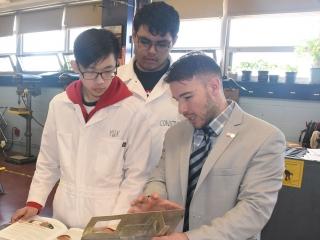“A good portion of our students go from high school directly to the workplace and they’ve never had a job in their lives before,” said Vaz, the school’s chapter leader.
Vaz said it’s important for students entering the workforce to understand that “the rules apply to your boss as much as they apply to you.”
Pepenella said his own experience as a union member inspired him to share that with his students.
“I like to exercise my rights as a UFT member, so I think they should be aware that’s available in the world of work,” he said.
On the first day of class, the students receive a folder from their teachers called “A Manual for Success,” a 25-page document that contains a contract between “student mechanics” and their teachers, a letter to their parent or guardian explaining the arrangement and detailed information about classroom procedures, expectations and policies. The contract outlines the grievance procedure and the students’ obligations. After going over the material, students elect officers — a foreperson, an assistant foreperson and, sometimes, a union representative. Pepenella says the officers help give the students a voice.
“A lot of students are afraid to speak up,” he said, “but there’s that one student who will speak up on their behalf.”
The officers also help mediate and de-escalate conflicts among the students.
“When the teacher is busy, I supervise the whole class,” said Rossalin Lema, who serves as the foreperson for her class. “This is teaching me how to have responsibility.”
Some students say the experience proved as useful for them in college as it did for their classmates heading directly into the working world.
“I look back fondly on my responsibilities, which played a large role in developing my interpersonal skills today,” said Eugene Liang, who is in his third year at the State University of New York at Buffalo. Liang served as a union representative in a shop class during his time at Aviation HS.
The students have used their collective bargaining rights to negotiate short breaks and access to drinking water for the lengthy shop classes, which used to run uninterrupted through three periods. The students also used to spend all that time on their feet because so much of their work involves physical activity, such as cleaning aircraft parts. But through their union, they won the right to sit during lesson periods.They have also pushed back when they felt a teacher was being unfair.
“I wanted to give a surprise quiz because of a handful of students’ behavior,” said Vaz. “They just took it to their union rep, and their union rep pulled me aside and advocated for the students. We negotiated like adults.”
Vaz conceded that his attempt to use a quiz as a disciplinary tool was in violation of the classroom contract.
The class union has met with mixed reviews from other teachers at the school. Some teachers have clarified to new students that there are no collective bargaining rights in their classroom while other teachers have begun instituting their own classroom unions or encouraging their students to self-organize.
But even this discrepancy reflects the workplace reality the Aviation HS students can expect after graduation.
“Some airlines are unionized, some aren’t,” said Pepenella. Still, he said, “it’s important to instill union values in the kids.”
One benefit of those values, said Vaz, is that having rules for both teachers and students makes the students more likely to follow the rules.
“When they’re speaking, we’re very respectful and quiet,” he said. The teachers expect — and usually receive — the same respect from the students.
“We always say that it’s our classroom,” said Vaz, “not my classroom.”



